 May 1, 2008
May 1, 2008
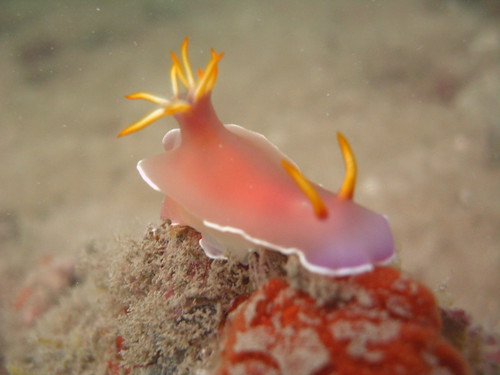





Sorry this has taken awhile! Our server was out of sorts for a bit and we’ve had to sort it out. Nonetheless, here it is at last – evidence of a superb dive at Hantu with old friends and new! (Above: Bullocki nudibranch)

As much as Hantu’s infamous visibility can hinder a divers comfort, a day of good visibility is a cause for celebration! And we don’t mean pop the bubbly, we mean spot as many critters can you can and take all the wide angles you never thought possible! This Sunday’s clear waters has been a long time coming because experience tells us that the water tends to clear up after the monsoons. But as we’re all aware, patterns in the weather have been going out of wack lately. Apart from the water being a welcome reprieve from the annoying heat we’ve been experiencing lately, it was also a tricky place to be with one of the largest jellyfish blooms we’ve ever known in 5 years! 3 divers including myself brought home a little souvenir from a brainless friend (read: jellyfish), and we’re still carrying the marks of the heated exchange 4 days later! (Above: detail of seafan)

The saying goes “there ain’t so such thing as a free lunch” so I suppose good vis and slack waters was perhaps too good to be true? In all honesty, it’s a bit of a concern the reason behind the jellyfish bloom. An excess of freshwater or higher temperatures lead to jellyfish blooms, but were these the factors that brought about a sea littered with jellyfish this weekend? Was the effluence from surrounding industries a cause? The cooling pipes in Bukom refinery have been known to be clogged with jellyfish in the past and reversing the flow of the pump was necessary to discharge the clogged jellyfish. Did something similar happen this time? Or are we looking at something larger than the immediate environment? Is it something regional? El Nino? A friend out in the northern waters of Singapore also reported a jellyfish bloom. So what’s going on? (Above: A diver photographs a nudibranch)

Because of the current works going on in Bukom with large ferries moving people too and fro the island, diving around the Hantu’s north channel seems to be disallowed. But we didn’t fret – taking advantage of the excuse to check out new diving sites that turned out to be as promising and from a whole different perspective! That said, we love diving the north channel because there’ve been some amazing things we’ve seen there like reticulated puffers, blotched sea cucumbers, the mesmerising giant hydriods with their tiny nudibranch inhabitants. Not to mention the seahorses, seasnakes and schools of rabbitfish and barracuda that see seem to encounter there and no where else. Hopefully we’d get to dive there again soon without any hassle. Every reef surrounding Hantu is precious. (Above: Damsel in carafe)
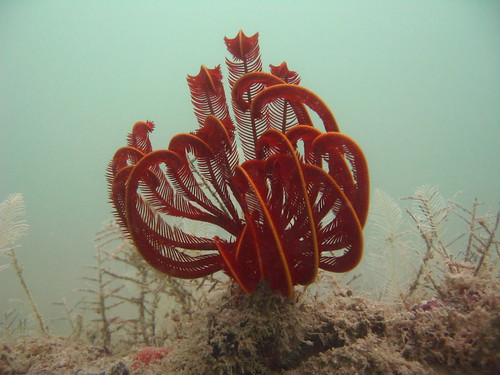
I was reminded of ReefXplore instructor Jani when I encountered this maroon-coloured crinoid. Jani used to love photographing these guys. Especially if they were red as that was her favourite colour… Check out her fantastic albeit backdated Blog on her research in Singapore waters!
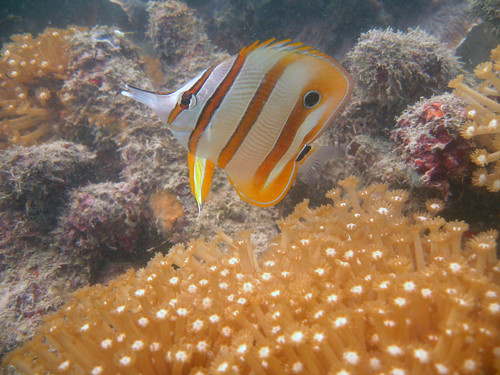
Especially because we g diving in the north channel a miss this month, it’d be really good to revisit it in May or the following months to check out how things are getting on over there. I was particularly stressed that we might not be able to spot any seahorses this weekend because we didn’t dive the usual spots and were not sure where to find them, but… find them we did!
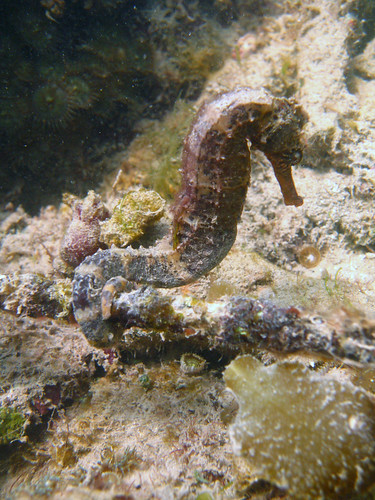
And I suppose it was good to be pushed to check out other sites, find new stuff and identify new spots to find some of our favourite critters! Check out more pix form this weekend’s dive at our Gallery, or swing by the following blogs and weblogs to read more accounts from Sunday’s dive!
Samson’s Manta’s World of Nature’s Goodies
HB’s Memories
Chay Hoon’s Colourful Clouds
 Posted in Blog Log
Posted in Blog Log  1 Comment »
1 Comment »
 April 27, 2008
April 27, 2008

I’m sure some of you who couldn’t make it for this dive have been wondering how much you’ve missed. The consolation is that you didn’t miss the coral spawning, but you still missed on some truly incredible night diving! (Above: Anemone with ascidians)

Marine biologist Jeffery Low was the unofficial scientific officer for this dive, which was also advised by Karrene Tun, another biologist who recommended the day for our dive. Karrene had been monitoring the development of egg sacs within the coral in specific sites in Singapore, and will be conducting certain experiments to better understand the reproduction of corals and the environmental factors that threaten or support them. (Above: Sleeping fish)
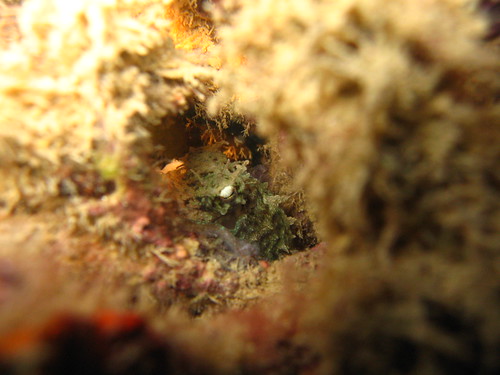
We set up 4 transects along the fringing reef and assigned a pair of buddies to work along each 20m transect. The point of the transect was simply to avoid double counting any corals that had spawned. So each buddy hung out and of course they didn’t just twiddle their thumbs as they indefinitely waited for the corals to spawn! With some of the most advanced spotters the Blog has ever encountered, camera flashes were ablaze across the reef as some of the most minute to some of the truly largest creatures on the reef were being photographed and observed! (Above: Octopus)










The night began with our encounter with Betsy the large hawksbill turtle as I posted yesterday. She truly is a large one and this time we weren’t just guessing! Because she was lying right next to the transect tape we were literally able to measure her up! From head to base of carapace, she measured about a meter! Her shell was covered with algae and freckled with barnacles. I’m blown away just thinking about how old she might be and the changes she must’ve witnessed and experienced as a turtle living in Singapore. Did she get a chance to mate? Did she ever return to shore to lay her eggs? I wonder, I wonder… (Above: [top row] Coral crab, shrimp, swimmer crab, eight-banded butterflyfish, flatworms [bottom row] box crab, swimmer crab, decorator crab, ‘closed’ crinoid, ‘open’ crinoid)

Some things you don’t have to wonder about though, is the myriad of macro (and mega) fauna that dotted every bit of reef, which certainly bursts into a spectacle of life at night. I’ll let the following images of shrimps, crabs, tiny fish, and some amaturish videos, do the talking. The only other largish animal I encountered on the reef was the blue spotted fan tail ray, which I was too absorbed watching that I at first forgot but later decided not to document (sorry!). To understand what it’s like, perhaps you’ll have to let yourself experience it first hand… (Above: Acopora goby)
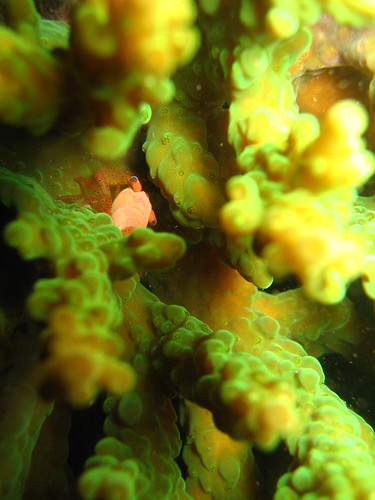
A rare find: Divers are more used to finding this Imperial shrimp riding on the backs of the Spanish dancer nudibranch. Here is finds safety in an Acopora coral.
A young Yellow-finned angelfish tries to remain safe from predators by hiding deep within this coral, but safety doesn’t come easy on the reef. Several predators look for food by creeping within the corals as well.
 Posted in Biology, Blog Log, Events
Posted in Biology, Blog Log, Events  No Comments »
No Comments »
 April 27, 2008
April 27, 2008
Wow! So much has happened this week! From the dive on Thursday in an attempt to catch this years coral spawning, to the talk on Saturday at the Botanical Gardens, now I’m getting ready for tomorrow’s dive! Phew! But one thing at a time! Here’s a taste of what our Earth Day night dive at Hantu on Thursday was like. Stay tuned for more pix and a more indepth post! Meet Betsy – the ginormous resident hawksbill turtle at Hantu. Inevitably she was disturbed in her sleep when we took this video, so please enjoy it as bast as you can! Move videos to be uploaded soon!
 Posted in Blog Log
Posted in Blog Log  2 Comments »
2 Comments »
 April 21, 2008
April 21, 2008

This year’s mass coral spawning in Singapore is estimated to fall over the next few days, from 23 – 25 April, 2008. As this period falls over Earth Day week, we’re making this dive a part of our Earth Day 2008 activities!
If you’d like to join us for this dive, you have at least be an advanced open water diver or its equivalent. You are required to have a camera and your own slate. Divers will be paired up and required to survey a designated zone around Hantu Island. Details of the spawning (should it happen! there’s no guarantee!) such as the time, depth, species, and it’s location should be recorded. This data will be collated with surveys being done in other areas of Singapore, and will help scientists in understanding the factors that influence coral reproduction in Singapore and the nearby regions.
Time: 1800 – 2200 hrs
Venue: Pasir Panjang Ferry Terminal
Cost: $95.00
Registration for this dive has closed.
 Posted in Biology, Blog Log, Events
Posted in Biology, Blog Log, Events  No Comments »
No Comments »
 April 21, 2008
April 21, 2008

DATE & TIME : Saturday 26 April 2pm – 1pm
VENUE : Function Hall Botany Centre, Singapore Botanical Gardens.
Synopsis: Pulau Hantu is one of Singapore’s most renowned Southern Islands. Despite its prominence, it is constantly left to cope with a relentlessly changing coastline and marine environment. For a long time, the threats to Pulau Hantu have avoided the scrutiny of the public and the brilliance of its marine habitat gone unheralded. Debby Ng will bring clarity to the usually murky waters of Pulau Hantu with her underwater photos and videos.
About the speaker: Debby Ng is a full-time environmental journalist. She began her work in film and moved on to television, but eventually realised that she gained the most satisfaction from communicating her concerns on the environment through her photography and writing. Her work has been published in several regional and international magazines, including the award-winning Lebanese magazine, Environment & Development. She has also worked with numerous Asian and international non-government organisations such as the World Wide Fund for Nature (WWF), and the Environmental Investigation Agency (EIA). In 2005 she assisted the Indonesian government in their assessment of fisheries, a project funded by The World Conservation Union (IUCN), the only conservation organisation with official observer status at the United Nations. Debby Ng is founder of the Hantu Blog, an education and awareness project powered entirely by volunteers and utilising free electronic media. She is also a volunteer dive guide and a freelance nature guide with Creative Kids.
 Posted in Events, Seminars
Posted in Events, Seminars  No Comments »
No Comments »
 April 21, 2008
April 21, 2008
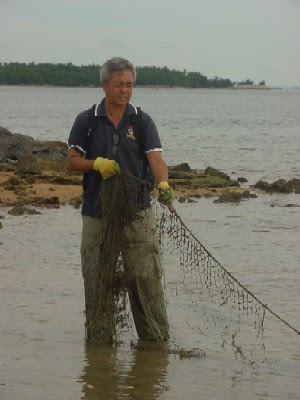
While most people are waiting for April 22, Earth Day to do their bit for the environment, nature enthusiast, educator, poet, and naturalist in his own right, Joseph Lai, has already swung into action to help save local reefs a tangle at a time.
Whilst I was at ADEX on Saturday, Joseph was leading a group of young people concerned about the environment and eager to do their bit, into the intertidal reefs of Pulau Hantu to remove a discarded fishing net that had become tangled in the reef. More at Joseph’s Blog.

When fishing nets are discarded they are referred to as ghost nets, so called because they drift carelessly in the ocean, snaring all sorts of wildlife from corals to pelagic and reef animals. Because they are not degradable, these nets continue to harm marine and coastal life throughout their indefinite “lifetimes”.

Remember, you don’t have to wait for an event to do your bit for the environment. It’s way more effective to work little bits of positive acts for the environment into your daily life. But in order to amplify your actions, not only should you passively try to reduce your consumption and try to live sustainably, but you should actively reach out to others and encourage them to live the way you do.
George Monbiot is the author of the best selling books The Age of Consent: a manifesto for a new world order, Captive State: the corporate takeover of Britain, and Heat: How to stop the Planet Burning. In an interview with New Consumer he suggests…
“There is absolutely one cast iron rule and that is that you don’t [make a difference] by yourself. You have to work with other people and in nearly all cases there are already groups which you can join. Never try to precipitate political change by yourself, it’s just not going to work. The lone voice might sound romantic but it’s not effective. For this to work you will have to work with others.”
Before you get all depressed thinking about how many plastic bags you have refused at the supermarket and how this doesn’t make a difference on a global scale, remember, that BEFORE you get to convincing others or working with others, you have to begin by working with yourself. When you’re convinced of your actions, and it’s roll-on effect, only then can you convincingly incur that same belief in others. It really depends on how far along you are, but it’s good to keep Monbiot’s philosophy in mind. If you’re already in the habit of making a difference, why not expand on it and have others make that same difference? But if you’re still getting used to it, go easy on yourself and keep on working at getting that spark to transform into an endearing flame.
 Posted in Announcements, Blog Log
Posted in Announcements, Blog Log  No Comments »
No Comments »
 April 20, 2008
April 20, 2008
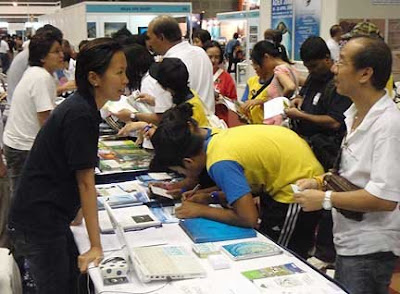
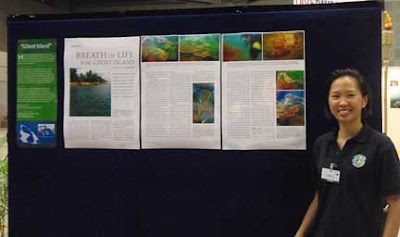
Thanks to Ria for posting these pictures and her comments of the local conservation outreach efforts at ADEX today (April 19)! Without her swift photo taking action I wouldn’t have the opportunity to generate this little blog!
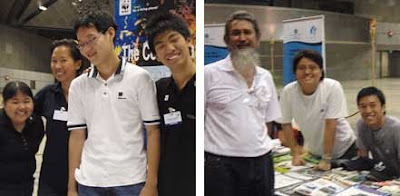

Not only did the event allow an exchange of information between nature groups and the public, but it proved to be a great platform for networking between volunteers from various fields of environmental work.

Diversity is important in environmental protection work because it is an extremely dynamic and organic movement that truly requires the synergy of organisations and individuals in order to be effective and up to speed.
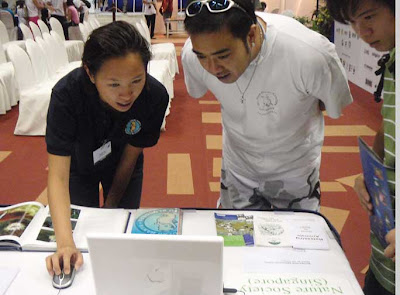
It was inspiring to be amongst other similarly passionate individuals and motivating to meet young people who felt strongly about the environmental cause! Thanks to the ADEX organisers for kindly providing an area for Eco Village and kudos to them for conceiving such a great idea!
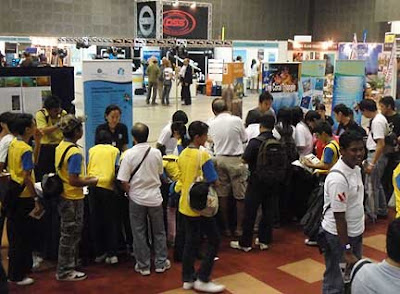
To read more about the other groups that participated and to view all the above pictures and more, visit the Wildfilms Blog and the IYOR Singapore Blog! If you missed us today, you can still catch us tomorrow (April 20) for the final day of the expo! Hope to see you there!
 Posted in Events
Posted in Events  No Comments »
No Comments »
 April 20, 2008
April 20, 2008
DATE & TIME : Tuesday 22 April 11am – 12pm
VENUE : Function Hall Botany Centre

Join Mr Jeffrey Low as he shares with us the splendor of our local coral reefs.
Synopsis: To start off the Biodiversity Talk series is our very own Mr Jeffrey Low from the National Biodiversity Centre Branch. He will share with us the splendor of Singapore’s coral reefs through an array of beautiful photos. Come join him in the exploration of our local coral reefs in the comfort of your chair.
About the Speaker: Jeffrey graduated from NUS in with a Bachelors of Science degree in 1988, and obtaining his Masters degree in 1999. He has worked on coral reef-related projects as a Research Assistant with NUS, first at the Reef Ecology Laboratory and then at the Tropical Marine Science Institute. He joined NParks in 2003 as a Senior Biodiversity Officer, overseeing development and marine conservation issues in the southern islands of Singapore.
 Posted in Announcements, Seminars
Posted in Announcements, Seminars  No Comments »
No Comments »
 April 19, 2008
April 19, 2008

This year’s Asia Dive Expo will be from 18-20 April at Suntec, Singapore. At the International Convention & Exhibition Center.
The Hantu Blog will be present at the inaugural ADEX Eco Village as part of the International Year of the Reef group of organisations. Join the Hantu Blog along with other local groups and NGOs in bringing the environmental message to the regions largest expo, and one of the several global industries that depend on the health of the oceans in order to profit.
 Posted in Events
Posted in Events  2 Comments »
2 Comments »
 April 11, 2008
April 11, 2008

Pulau Hantu’s iconic sea critter, the Tigertail seahorse, makes its North American debut at Nature Online, the Web site of the popular American public television series Nature. The series is produced by channel Thirteen/WNET New York, the highest-rated public TV station in the US, offering a wealth of programming from the Public Broadcasting Service. The non-profit corporation also operates WLIW21, public television, presenting programming and outreach projects that educate, enlighten and entertain, as well as several digital channels, and on-demand video services. Thirteen/WNET began broadcasting in 1962.
The Tigertail seahorse is part of a Web feature for an article about interesting mating antics. Follow the above link and click “See the answers” at the bottom of the page to be taken to the page where the photo is displayed!
It’s great that The Hantu Blog, a free public education service, is able to contribute to a similar outreach vehicle half way across the planet. Because Nature Online will have an enormous reach not just to people in the US but to people all over the world, we hope our Seahorse ambassador and our Blog will garner the attention that our reefs need in order to survive the next seven generations.
Free public television has been so important in the nurturing of society’s less privileged since the 1970s. In an era where everyone watches cable television, it’s hard to imagine a world without it. But a majority of society still depends on public television to have fun, learn and be influenced. The even better news is that today, there’s more information that can be freely accessed (and delivered!) than ever before. So there’s really no excuse to be misinformed anymore.
 Posted in Announcements, News
Posted in Announcements, News  No Comments »
No Comments »
 May 1, 2008
May 1, 2008 











 Posted in
Posted in 

































 content rss
content rss
COMMENTS